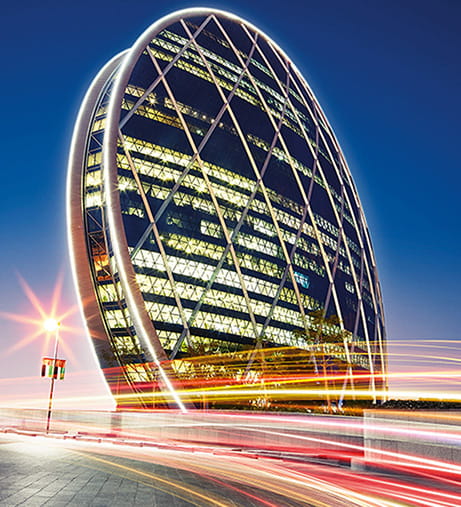#Featured
November 26, 2023
Explore Incredible Sustainable Architecture in Abu Dhabi
Sustainable Architecture involves integrating sustainability and design principles to create buildings that minimize environmental impact while maximizing efficiency. This approach to sustainable housing focuses on crafting sustainable homes that meet current needs without compromising the ability of future generations to meet their own.
Incorporating eco-friendly practices into architecture means prioritizing the use of eco-friendly materials, employing efficient construction methods, and ensuring responsible resource management. Sustainable architecture is guided by a design philosophy that encompasses the entire lifecycle of a building, from initial construction through to its eventual demolition. This holistic approach aims not only for functional and aesthetic excellence but also for enduring energy and resource efficiency.
By embracing sustainability and design, architects and builders can create homes that are not only beautiful and functional but also contribute to a healthier planet and a more sustainable future.
Benefits of Sustainable Architecture
Sustainable architecture (sometimes called eco-friendly architecture) offers several advantages for both individuals and communities, impacting various aspects of life:
-
Lower Carbon Emissions
A key benefit is its ability to lower carbon emissions. For instance, while natural gas releases 0.6 to 2 pounds of carbon dioxide per kilowatt-hour, renewable sources like solar power emit significantly less, at just 0.07 to 0.04 pounds. This makes natural gas emissions about 186% higher than solar energy. -
Multi-Purpose Vegetation Cover
An example of green sustainable architecture practices is “living walls”: vertical gardens that use hydroponics for plant growth, mixed with the natural elements essential for their growth. They offer many advantages, such as:
- Improving air quality
- Supporting mental health
- Reducing heat loss from buildings by 30%
The Importance of Sustainable Architecture
The 2017 United Nations Global Environment Report highlights the significant role of buildings and construction in global energy use and carbon dioxide emissions, accounting for over 35% of energy consumption and nearly 40% of CO2 emissions from energy generation. Despite a decrease in these figures since 2010 due to growing sustainability awareness, there remains a pressing need for further action. Sustainable architecture is essential, not merely a trend, but a vital response to environmental challenges.
This approach to architecture combines building design with environmental considerations, functionality, and the building’s interaction with its surroundings. The aim is to achieve a balance, creating aesthetically pleasing and functional structures while being environmentally responsible and sustainable in resource use.
The UAE’s Green Agenda - 2030
-
Integrated Urban Planning
Developing urban planning that aligns with environmental needs.
-
Environmental Studies
Researching environmentally sensitive areas and urban heat island effects.
-
Sustainable Building Program
A national initiative promoting sustainable green architecture and construction practices.
-
Sustainable Infrastructure Legislation
Enacting laws for sustainability and environmental considerations in road infrastructure.
-
Sustainable Architecture Standards for Public Housing
Implementing international standards and sustainable energy practices in residential projects.
-
Green Building Materials
Supporting the purchase and development of eco-friendly building materials.
-
Rationalising Energy and Water Consumption
Legislating to enhance energy and water efficiency in buildings.
-
Autonomous Homes
Encouraging the development of energy self-sufficient homes.
-
Residential Sustainability Standards
Applying sustainability standards in residential complexes.
-
Global Partnerships in Energy Provision
Exploring international cooperation for energy provision.
Steps Taken by the UAE Towards Sustainability
The UAE has shown a strong commitment to sustainability, starting with ratifying the Paris Agreement in 2015 (the United Nations Framework Convention on Climate Change) and its initial national contribution aimed at achieving 24% clean energy by 2021. This commitment was further demonstrated through initiatives in infrastructure development, energy and water efficiency, management, and public awareness.
In 2020, the UAE revised its national goals, setting an ambitious target to reduce greenhouse gas emissions by 23.5% by 2030. This includes increasing clean energy usage, improving energy efficiency, advancing carbon capture technologies, preserving blue carbon ecosystems, fostering sustainable agriculture, and enhancing waste management strategies.
Your Role in Sustainable Architecture
Your contribution to sustainability through sustainable homes is crucial. It’s about making choices mindful of the environment and future generations and incorporating eco-friendly designs and architecture to make your home. Within sustainable architecture, it can manifest in different ways. For instance, if you own land with 100 rare trees yet want to build a house. Traditional methods might clear all trees, disregarding environmental impacts. However, sustainable architecture suggests different approaches:
- Exploring Alternatives: Is there barren land available that wouldn’t require removing the rare trees?
- Resource Management: How can wood be utilised sustainably to benefit others?
- Eco-Friendly Design: Can the house be constructed while preserving all or most of the trees?
Companies like Aldar are at the forefront of sustainable property development. Aldar’s varied sustainability strategies and programs exemplify how commercial investment firms can be leaders in incorporating sustainable practices into contemporary architecture. This significantly aids in achieving the United Arab Emirates’ extensive green objectives. By supporting these initiatives, individuals and companies can dramatically impact the global movement toward sustainable architecture.

